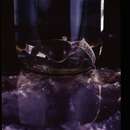en
names in breadcrumbs


Gastric brooding frogs cannot be tamed and always struggle when handled.
The advertisement call of the southern gastric brooding frog is a pulse with a slight upward inflection lasting for 0.5 seconds, repeated every 6 seconds.
Communication Channels: visual ; tactile ; acoustic ; chemical
Other Communication Modes: choruses
Perception Channels: visual ; tactile ; acoustic ; chemical
The gastric brooding frog has limited distributions, which has been detrimental to its existence. It is listed as endangered in the Appendix of the Convention on International Trade in Endangered Species of Wild Fauna and Flora. In 1973, when this species was discovered, they were extremely abundant, and believed common. Astonishingly, less than a decade after their discovery, they seemingly disappeared without a trace. There are several speculated causes for the population crash: drought, over-collection by herpetologists, habitat pollution by the logging industry and by the damming of the creeks for the gold-panning industry (Tyler, 1985). This species' permeable skin makes them especially susceptible to the pollution in their aquatic environment.
This species is currently listed as Extinct by the International Union for the Conservation of Nature. No individuals have been observed in the wild since 1981, despite extensive searches.
US Federal List: no special status
CITES: appendix ii
IUCN Red List of Threatened Species: extinct
Gastric brooding frog tadpoles develop in their mother's stomach for 6 to 7 weeks. The tadpoles do not feed during this time, as they lack tooth rows. The young develop at different rates and are birthed when they are ready; expelling all of the juvenile frogs may take several days.
Development - Life Cycle: metamorphosis
The ability to shut down the secretion of powerful digestive acids could have an important bearing in the medical treatment of humans who suffer from gastric ulcers.
The diet of R. silus consists mainly of small live insects. Once the prey is captured, the frog manipulates it further into the mouth with its forelimbs. Soft-bodied insects are eaten at the water surface, while stronger prey are taken underwater for consumption. Rheobatrachus silus has been observed catching insects on land as well as in water (Tyler, 1983).
Animal Foods: insects
Primary Diet: carnivore (Insectivore )
This species of frog is only found in the Blackall and Conondale Ranges in Southeastern Queensland, Australia (Barker, 1995).
Biogeographic Regions: australian (Native )
This frog is mostly aquatic and is found in rocky creek beds, adjacent pools, and rock pools in the Australian rainforest. It also lives along the rocky streams of the moist eucalyptus forest.
Habitat Regions: tropical ; freshwater
Terrestrial Biomes: forest ; rainforest
Aquatic Biomes: lakes and ponds; rivers and streams; temporary pools
Wetlands: marsh ; swamp
In captivity, individual R. silus have lived up to 3 years.
Range lifespan
Status: captivity: 3 (high) years.
The length of the oval-shaped R. silus ranges in females from 45 to 54 mm, and 33 to 41 mm in males. Extremely large eyes dorsally protrude from its small, flattened head (Tyler, 1983). The skin color on its back ranges from dull gray to slate, with obscure dark and light patches. When the background is pale, a broad brown and posteriorly curved, superocular bar is detectable (Barker, 1995). Its belly is marked with large creamy patches on a white surface. The feet of this frog are extensively webbed to suit its aquatic lifestyle.
Range length: 33 to 54 mm.
Other Physical Features: ectothermic ; heterothermic ; bilateral symmetry
Sexual Dimorphism: female larger
The two major predators of R. silus, white-faced herons and eels, inhabit the same streams as the frogs. The leaves from eucalyptus trees and stones along the stream banks aid in hiding this species from predators. When grasped, as an escape mechanism, they excrete a coat of mucus that enables them to slip away.
Known Predators:
The reproductive habits of the gastric brooding frog set it apart from other species. The breeding age for this frog is about two years. The process of egg deposition and amplexus has never been observed; it is only known that the eggs are ingested through the mouth (Barker, 1995). The female swallows between 18 and 25 fertilized cream-colored eggs, which develop in her stomach. During this 6 to 7 week period, the colorless tadpoles lack tooth rows and do not feed. The female also stops feeding entirely because of the egg jelly and chemicals secreted by the tadpoles which switch off the production of hydrochloric acid in the stomach wall (A.N.C.A., 1996). The entire digestive system shuts down, which prevents the digestion of the young. Birth is accomplished by the female widely opening her mouth and dilating her esophagus. The offspring are propelled from the stomach to the mouth, and then hop away.
The breeding season occurs during the spring and summer months. Though the warm temperatures of these months aren't essential for reproduction, rain and moisture are necessary (Tyler, 1983).
Range age at sexual or reproductive maturity (female): 2 (low) years.
Range age at sexual or reproductive maturity (male): 2 (low) years.
Key Reproductive Features: seasonal breeding ; gonochoric/gonochoristic/dioecious (sexes separate); sexual ; fertilization (External ); oviparous
Each female gastric brooding frog contributes yolk to her eggs, and then after they are fertilized, she swallows them and carries them in her stomach for 6 to 7 weeks. During this time, her digestive system shuts down and she cannot eat. Once the young are fully developed and expelled from her mouth, she has no further contact with them. Male gastric brooding frogs contribute nothing to the next generation except their sperm.
Parental Investment: pre-fertilization (Provisioning); pre-hatching/birth (Protecting: Female)